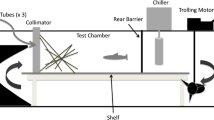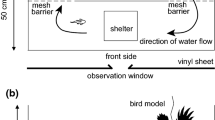Synopsis
Experiments were conducted to investigate the response of juvenile Atlantic salmon,Salmo salar, to changes in the location at which food entered a stream tank. Experience with the location of food input into the system significantly influenced foraging-site selection by the dominant fish. Dominant fish changed location of their foraging site in response to a change in the location of food input, and occupied, aggressively defending, sites just downstream of the location of food introduction. In contrast, subordinate fish occupied foraging sites at the downstream end of the stream tank, regardless of location of food input. As a result of both site selection and social status, dominant fish captured significantly more prey than subordinates. Our results support the contention that salmonids choose foraging sites to maximize foraging opportunities. Our results also provide a possible explanation for the use of ‘atypical’ foraging sites by individual fish within their home range over the course of a single day, as observed in a number of salmonid species in the field.
Similar content being viewed by others
References cited
Bachman, R.A. 1984. Foraging behavior of free-ranging wild and hatchery brown trout in a stream. Trans. Amer. Fish. Soc. 113: 1–32.
Chapman, D.W. & T.C. Bjornn. 1969. Distribution of salmonids in streams, with special reference to food and feeding. pp. 153–176. In: T.G. Northcote (ed.) Symposium of Salmon and Trout in Streams, H.R. MacMillan Lectures in Fisheries, University of British Columbia, Vancouver.
Cunjak, R.A. & J.M. Green. 1984. Species dominance by brook trout and rainbow trout in a simulated stream environment. Trans. Amer. Fish. Soc. 113: 737–743.
DeGraaf, D.A. & L.H. Bain. 1986. Habitat use by and preferences of juvenile Atlantic salmon in two Newfoundland rivers. Trans. Amer. Fish. Soc. 115: 671–681.
Everest, F.H. & D.W. Chapman. 1972. Habitat selection and spatial interaction by juvenile chinook salmon and steelhead trout in two Idaho streams. J. Fish. Res. Board Can. 29: 91–100.
Fausch, K.D. 1984. Profitable stream positions for salmonids: relating specific growth rate to net energy gain. Can. J. Zool. 62: 441–451.
Fausch, K.D. & R.J. White. 1981. Competition between brook trout (Salvelinus fontinalis) and brown trout (Salmo trutta) for positions in a Michigan stream. Can. J. Fish. Aquat. Sci. 38: 1220–1227.
Gibson, R.J. 1978. The behavior of juvenile Atlantic salmon (Salmo salar) and brook trout (Salvelinus fontinalis) with regard to temperature and to water velocity. Trans. Amer. Fish. Soc. 107: 703–712.
Godin, J.-G.J. 1978. Behavior of juvenile pink salmon (Oncorhynchus gorbuscha Walbaum) towards novel prey: influence of ontogeny and experience. Env. Biol. Fish. 3: 261–266.
Godin, J.-G.J. & M.H.A. Keenleyside. 1984. Foraging on patchily distributed prey by a cichlid fish (Teleostei, Cichlidae): a test of the ideal free distribution theory. Anim. Behav. 32: 120–131.
Gotceitas, V. & H.F. Clifford. 1983. The life history ofDicosmoecus atripes (Hagen) (Limnephilidae: Trichoptera) in a Rocky Mountain stream of Alberta, Canada. Can. J. Zool. 61: 586–596.
Gotceitas, V. & P. Colgan. 1988. Individual variation in learning by foraging juvenile bluegill sunfish (Lepomis macrochirus). J. Comp. Psychol. 102: 294–299.
Grant, J.W.A. 1990. Aggressiveness and the foraging behaviour of young-of-the-year brook charr (Salvelinus fontinalis). Can. J. Fish. Aquat. Sci. 47: 915–920.
Grant, J.W.A. & D.L.G. Noakes. 1987. A simple model of optimal territory size for drift-feeding fish. Can. J. Zool. 65: 270–276.
Grant, J.W.A., D.L.G. Noakes & K.M. Jonas. 1989. Spatial distribution of defence and foraging in young-of-the-year brook charr,Salvelinus fontinalis. J. Anim. Ecol. 58: 773–784.
Hughes, R.N. 1979. Optimal diets under the energy maximization premise: the effects of recognition time and learning. Amer. Nat. 113: 209–221.
Huntingford, F.A., N.B. Metcalfe & J.E. Thorpe. 1988. Choice of feeding station in Atlantic salmon,Salmo salar, parr: effects of predation risk, season and life history strategy. J. Fish Biol. 33: 917–924.
Jenkins, T.M. 1969. Social structure, position choice and microdistribution of two trout species (Salmo trutta andSalmo gairdneri) resident in mountain streams. Anim. Behav. Monogr. 2: 57–123.
Keenleyside, M.H.A. & F.T. Yamamoto. 1962. Territorial behaviour of juvenile Atlantic salmon (Salmo salar L.). Behaviour 19: 139–169.
Martin, I.D. & D.R. Barton. 1987. The formation of diapause aggregations by larvae ofNeophylax fuscus banks (Trichoptera: Limnephilidae) and their influence on mortality and development. Can. J. Zool. 65: 2612–2618.
McNicol, R.E. & D.L.G. Noakes. 1981. Territories and territorial defense in juvenile brook charr,Salvelinus fontinalis (Pisces: Salmonidae). Can. J. Zool. 59: 22–28.
McNicol, R.E., E. Scherer & E.J. Murkin. 1985. Quantitative field investigations of feeding and territorial behaviour of young-of-the-year brook charr,Salvelinus fontinalis. Env. Biol. Fish. 12: 219–229.
Metcalfe, N.B. 1986. Intraspecific variation in competitive ability and food intake in salmonids: consequences for energy budgets and growth rates. J. Fish Biol. 28: 525–531.
Morantz, D.L., R.K. Sweeney, C.S. Shirvell & D.A. Longard. 1987. Selection of microhabitat in summer by juvenile Atlantic salmon (Salmo salar). Can. J. Fish. Aquat. Sci. 44: 120–129.
Otto, C. & B.S. Svensson. 1981. Why doPotamophylax cingulatus (Steph.) (Trichoptera) larvae aggregate at pupation? Proceedings of the 3rd International Symposium on Trichoptera, Series Entomologica 20: 285–291.
Ringler, N.H. 1979a. Prey selection by benthic feeders. pp. 219–229. In: R. Stroud & H. Clepper (ed.) Predator-Prey Systems in Fishery Management, Sport Fishing Institute, Washington, D.C.
Ringler, N.H. 1979b. Selective predation by drift-feeding brown trout (Salmo trutta). J. Fish. Res. Board Can. 36: 392–403.
SAS Institute Inc. 1988. SAS/STAT User's Guide, Release 6.03 Edition. SAS Institute Inc., Cary. 1028 pp.
Sokal, R.R. & F.J. Rohlf. 1981. Biometry: the principles and practice of statistics in biological research, 2nd ed. W.H. Freeman and Company, San Francisco. 859 pp.
Wankowski, J.W.J. & J.E. Thorpe. 1979. Spatial distribution and feeding in Atlantic salmon,Salmo salar L. juveniles. J. Fish Biol. 14: 239–247.
Ware, D.M. 1971. Predation by rainbow trout (Salmo gairdneri): the effect of experience. J. Fish. Res. Board Can. 28: 1847–1852.
Waters, T.F. 1969. Invertebrate drift-ecology and significance to stream fishes. pp. 121–134. In: T.G. Northcote (ed.) Symposium on Salmon and Trout in Streams, H.R. MacMillan Lectures in Fisheries, University of British Columbia, Vancouver.
Werner, E.E., G.G. Mittelbach & D.J. Hall. 1981. The role of foraging profitability and experience in habitat use by the bluegill sunfish. Ecology 62: 116–125.
Wilzbach, M.A. 1985. Relative roles of food abundance and cover in determining the habitat distribution of stream-dwelling cutthroat trout (Salmo clarki). Can. J. Fish. Aquat. Sci. 42: 1668–1672.
Author information
Authors and Affiliations
Rights and permissions
About this article
Cite this article
Gotceitas, V., Godin, JG.J. Effects of location of food delivery and social status on foraging-site selection by juvenile Atlantic salmon. Environ Biol Fish 35, 291–300 (1992). https://doi.org/10.1007/BF00001896
Received:
Accepted:
Issue Date:
DOI: https://doi.org/10.1007/BF00001896




